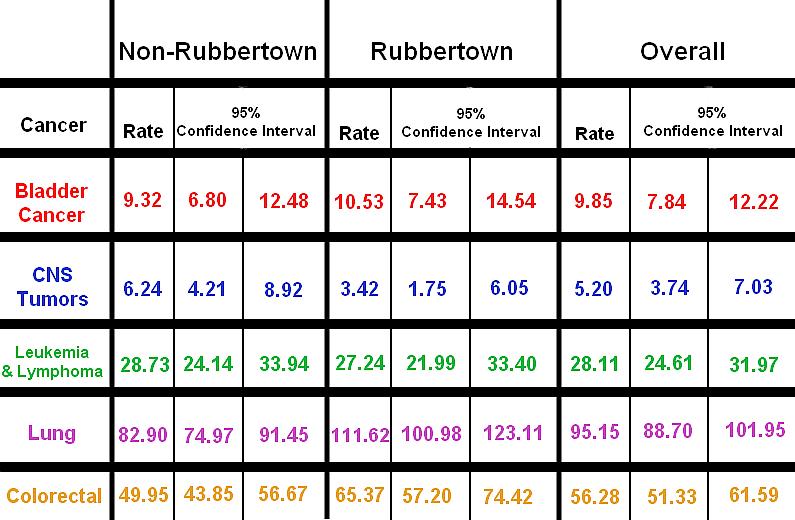Lung, Colon Cancer Rates Higher Near Rubbertown Than Other Louisville Neighborhoods
Erica Peterson’s month long series reporting on health issues in Rubbertown, Kentucky, for WFPL, Louisville Public Radio, was undertaken as a 2012 National Health Journalism Fellow. Stories in the series include:
Louisville's air program marks successes, but health concerns linger
Air Issues Plague Park DuValle, One of Louisville's Newest Planned Communities
Rubbertown Odor a Nuisance, But is it Illegal? Hard to Tell
Patients, Widows, Researchers Still Dealing With Toxic Legacy of Rubbertown Chemical
Riverside Gardens: A Former Resort Community Besieged By Pollution
Interstate Traffic Makes Air Quality in Rubbertown Worse
No End in Sight for Clash Between Residents, Rubbertown Industry

A new analysis shows that certain cancers are more prevalent in areas near the Rubbertown neighborhood in west and southwest Louisville. But it’s impossible to determine what role—if any—pollution from nearby industries plays in the elevated cancer rates.
Everyone in Rubbertown knows someone with cancer. But are people in these neighborhoods actually more likely to get cancer than other Louisville residents? I called someone who should know: Dr. Tom Tucker, the head of the Kentucky Cancer Registry.
The Kentucky Cancer Registry is a repository of information about every cancer case in the state since 1994. By law, doctors are required to tell the registry when a patient is diagnosed.
So I had Tucker run an analysis of his data.
The study
The smallest way to group the data was by zip code, so I had to settle for looking at the two zip codes that encompass Rubbertown and its environs—and incidentally, also a good portion of West Louisville.
Besides being heavily polluted, these zip codes are also among the poorest in the city. And low income often comes with other risk factors for poor health, like less access to health care, bad diets and smoking. So to make the fairest comparison possible, I had Tucker pit those West End zip codes against five others—all within the city limits and with a similar median household income.
Tucker looked at a few cancers that are known to be influenced by environmental factors, like bladder cancer, tumors of the central nervous system and leukemia. Those weren’t significantly higher in the Rubbertown zip codes. But common cancers—lung cancer and colorectal cancer—were significantly higher in Rubbertown than in the other zip codes we compared them to.
How much higher? People in the zip codes near Rubbertown are nearly 35 percent more likely to develop lung cancer than those in the other areas we looked at. And they’re about 31 percent more likely to be diagnosed with colorectal cancer than people in the other zip codes.
Inflammation, toxins and cancer
Take colon cancer. There are lots of factors that dictate whether someone develops it—like early screening and a healthy diet. But environmental toxins like PCBs could play a role by creating or exacerbating inflammation.
“We know that inflammation and cancer are tied part and parcel together,” Dr. Tad Dryden said. He’s an associate professor of medicine and bioengineering at the University of Louisville, and he specializes in colon cancer. “And we know that essentially 75 percent of all cancers have some sort of inflammatory component to them. So inflammation is an important driver of cancer.”
As for lung cancer, cigarette smoking is the disease’s number one cause. But studies have also shown that smokers who are exposed to environmental factors like asbestos or radon are even more likely to develop cancer than smokers without the environmental exposure.
This isn’t the first look at cancers near Rubbertown; a study by the Kentucky Department for Public Health looked at cancers in the 40216 zip code as recently as 2011. There were 2693 cases of cancer in the area between 1999 and 2008. This was higher than the expected number of 2074, considering the area’s population and age adjusted cancer rate. In an email to Carl Blair of the federal Agency for Toxic Substances and Disease Registry, epidemiologist Colleen Kaelin says that’s not high enough to set off any red flags.
“The ratio of observed to expected cases of all types of cancer is 1.43,” she wrote. “The guidelines established by the Centers for Disease Control state that generally the number of observed cases should exceed the number of expected cases by 2 to 3 times before an environmental investigation is considered.”
Environment's role is unknown
This new analysis of the available data suggests only that the rates for colon and lung cancer are higher in the two zip codes near Rubbertown than in several other comparable zip codes. There are several factors that increase the risk of these cancers that have nothing to do with the environment, but Tucker says that doesn’t mean environmental factors don’t play a role.
“And while we are unable to show a statistical difference between those tumors with known environmental exposures; that doesn’t mean it’s not possible they’re there, we simple are unable to do it with the information and data that’s available,” he said.
Bottom line: cancer is complicated. No matter what the data may seem to imply, it’s nearly impossible for doctors to make a link between a type of cancer and exposure to one specific chemical or pollutant. But there’s one exception: a chemical called vinyl chloride. And that’s the chemical thousands of Rubbertown workers were exposed to between the 1940s and 1970s—and the cause of liver disease and liver cancer in many of them.
This story was originally published in WFPL.org on January 14, 2013
Photo Credit: Erica Peterson

